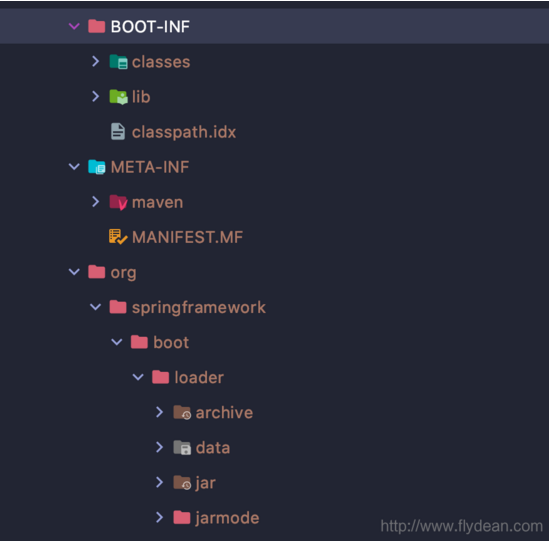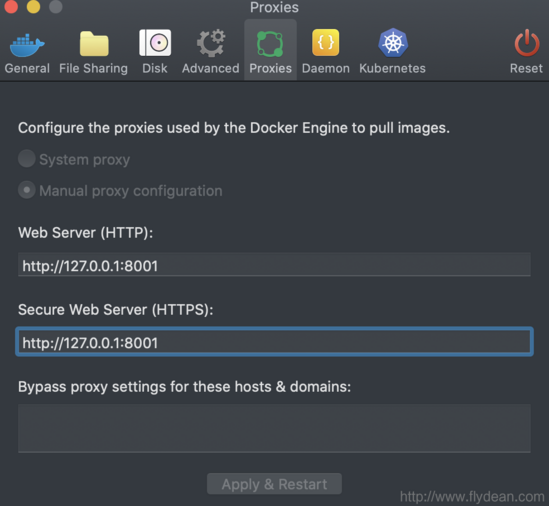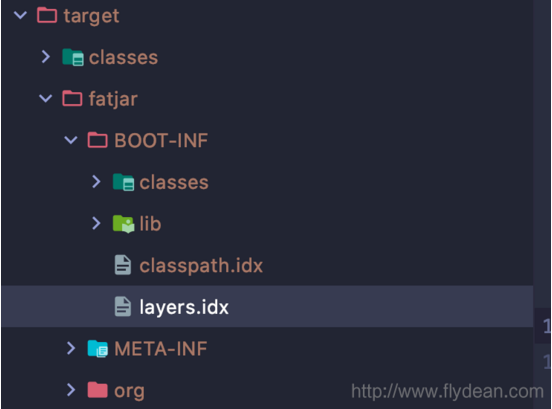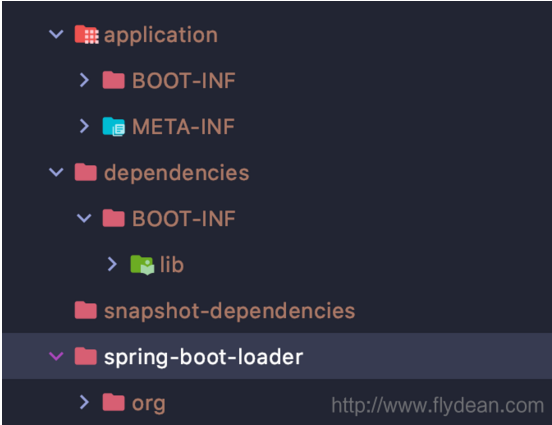前言
在很久很久以前,我们是怎么创建Spring Boot的docker image呢?最最通用的办法就是将Spring boot的应用程序打包成一个fat jar,然后写一个docker file,将这个fat jar制作成为一个docker image然后运行。
今天我们来体验一下Spring Boot 2.3.3 带来的快速创建docker image的功能。
传统做法和它的缺点
现在我们创建一个非常简单的Spring Boot程序:
|
1
2
3
4
5
6
7
8
9
10
11
12
13
|
@SpringBootApplication@RestControllerpublic class Application { public static void main(String[] args) { SpringApplication.run(Application.class, args); } @GetMapping("/getInfo") public String getInfo() { return "www.flydean.com"; }} |
默认情况下,我们build出来的是一个fat jar:springboot-with-docker-0.0.1-SNAPSHOT.jar
我们解压看一下它的内容:

Spring boot的fat jar分为三个部分,第一部分就是BOOT-INF, 里面的class目录放的是我们自己编写的class文件。而lib目录存放的是项目依赖的其他jar包。
第二部分是META-INF,里面定义了jar包的属性信息。
第三部分是Spring Boot的类加载器,fat jar包的启动是通过Spring Boot的jarLauncher来创建LaunchedURLClassLoader,通过它来加载lib下面的jar包,最后以一个新线程启动应用的Main函数。
这里不多讲Spring Boot的启动。
我们看一下,如果想要用这个fat jar来创建docker image应该怎么写:
|
1
2
3
4
5
|
FROM openjdk:8-jdk-alpineEXPOSE 8080ARG JAR_FILE=target/springboot-with-docker-0.0.1-SNAPSHOT.jarADD ${JAR_FILE} app.jarENTRYPOINT ["java","-jar","/app.jar"] |
这样写有两个问题。
第一个问题:我们是用的far jar,在使用far jar的过程中会有一定的性能问题,肯定要比解压过后的性能要低,尤其是在容器环境中运行的情况下,可能会更加突出。
第二个问题:我们知道docker的image是按layer来构建的,按layer构建的好处就是可以减少image构建的时间和重用之前的layer。
但是如果使用的是fat jar包,即使我们只修改了我们自己的代码,也会导致整个fat jar重新更新,从而影响docker image的构建速度。
使用Buildpacks
传统的办法除了有上面的两个问题,还有一个就是需要自己构建docker file,有没有一键构建docker image的方法呢?
答案是肯定的。
Spring Boot在2.3.0之后,引入了Cloud Native 的buildpacks,通过这个工具,我们可以非常非常方便的创建docker image。
在Maven和Gradle中,Spring Boot引入了新的phase: spring-boot:build-image
我们可以直接运行:
|
1
|
mvn spring-boot:build-image |
运行之,很不幸的是,你可能会遇到下面的错误:
[ERROR] Failed to execute goal org.springframework.boot:spring-boot-maven-plugin:2.3.3.RELEASE:build-image (default-cli) on project springboot-with-docker: Execution default-cli of goal org.springframework.boot:spring-boot-maven-plugin:2.3.3.RELEASE:build-image failed: Docker API call to 'localhost/v1.24/images/create?fromImage=gcr.io%2Fpaketo-buildpacks%2Fbuilder%3Abase-platform-api-0.3' failed with status code 500 "Internal Server Error" and message "Get https://gcr.io/v2/: net/http: request canceled while waiting for connection (Client.Timeout exceeded while awaiting headers)" -> [Help 1]
这是因为我们无法从gcr.io中拉取镜像!
没关系,如果你会正确的上网方式的话,那么我估计你已经找到了一个代理。
将你的代理配置到Docker的代理项里面,我使用的是Docker desktop,下面是我的配置:

重新运行 mvn spring-boot:build-image
等待执行结果:
[INFO] --- spring-boot-maven-plugin:2.3.3.RELEASE:build-image (default-cli) @ springboot-with-docker ---
[INFO] Building image 'docker.io/library/springboot-with-docker:0.0.1-SNAPSHOT'
[INFO]
[INFO] > Pulling builder image 'gcr.io/paketo-buildpacks/builder:base-platform-api-0.3' 0%
[INFO] > Pulling builder image 'gcr.io/paketo-buildpacks/builder:base-platform-api-0.3' 0%
[INFO] > Pulling builder image 'gcr.io/paketo-buildpacks/builder:base-platform-api-0.3' 0%
[INFO] > Pulling builder image 'gcr.io/paketo-buildpacks/builder:base-platform-api-0.3' 0%
[INFO] > Pulling builder image 'gcr.io/paketo-buildpacks/builder:base-platform-api-0.3' 0%
[INFO] > Pulling builder image 'gcr.io/paketo-buildpacks/builder:base-platform-api-0.3' 0%
你可以看到,我们的确是需要从gcr.io拉取image。
Layered Jars
如果你不想使用Cloud Native Buildpacks,还是想使用传统的Dockerfile。 没关系,SpringBoot为我们提供了独特的分层jar包系统。
怎么开启呢? 我们需要在POM文件中加上下面的配置:
|
1
2
3
4
5
6
7
8
9
10
11
12
13
|
<build> <plugins> <plugin> <groupId>org.springframework.boot</groupId> <artifactId>spring-boot-maven-plugin</artifactId> <configuration> <layers> <enabled>true</enabled> </layers> </configuration> </plugin> </plugins> </build> |
再次打包,看下jar包的内容:

看起来和之前的jar包没什么不同,只不过多了一个layers.idx 这个index文件:
|
1
2
3
4
5
6
7
8
9
10
|
- "dependencies": - "BOOT-INF/lib/"- "spring-boot-loader": - "org/"- "snapshot-dependencies":- "application": - "BOOT-INF/classes/" - "BOOT-INF/classpath.idx" - "BOOT-INF/layers.idx" - "META-INF/" |
index文件主要分为4个部分:
- dependencies – 非SNAPSHOT的依赖jar包
- snapshot-dependencies – SNAPSHOT的依赖jar包
- spring-boot-loader – Spring boot的class loader文件
- application – 应用程序的class和resources文件
注意,这里的index文件是有顺序的,它和我们将要添加到docker image中的layer顺序是一致的。
最少变化的将会最先添加到layer中,变动最大的放在最后面的layer。
我们可以使用layertools jarmode来对生成的fat jar进行校验或者解压缩:
|
1
2
3
4
5
6
7
8
|
java -Djarmode=layertools -jar springboot-with-docker-0.0.1-SNAPSHOT.jar Usage: java -Djarmode=layertools -jar springboot-with-docker-0.0.1-SNAPSHOT.jarAvailable commands: list List layers from the jar that can be extracted extract Extracts layers from the jar for image creation help Help about any command |
使用list命令,我们可列出jar包中的layer信息。使用extract我们可以解压出不同的layer。
我们执行下extract命令,看下结果:

可以看到,我们根据layers.idx解压出了不同的文件夹。
我们看一下使用layer的dockerFile应该怎么写:
|
1
2
3
4
5
6
7
8
9
10
11
12
13
|
FROM adoptopenjdk:11-jre-hotspot as builderWORKDIR applicationARG JAR_FILE=target/*.jarCOPY ${JAR_FILE} application.jarRUN java -Djarmode=layertools -jar application.jar extractFROM adoptopenjdk:11-jre-hotspotWORKDIR applicationCOPY --from=builder application/dependencies/ ./COPY --from=builder application/spring-boot-loader/ ./COPY --from=builder application/snapshot-dependencies/ ./COPY --from=builder application/application/ ./ENTRYPOINT ["java", "org.springframework.boot.loader.JarLauncher"] |
这样我们的一个分层的DockerImage就创建完成了。
自定义Layer
如果我们需要自定义Layer该怎么做呢?
我们可以创建一个独立的layers.xml文件:
|
1
2
3
4
5
6
7
8
9
10
11
12
13
14
15
16
17
18
19
20
21
22
23
24
25
26
27
|
<layers xmlns="http://www.springframework.org/schema/boot/layers" xmlns:xsi="http://www.w3.org/2001/XMLSchema-instance" xsi:schemaLocation="http://www.springframework.org/schema/boot/layers https://www.springframework.org/schema/boot/layers/layers-2.3.xsd"> <application> <into layer="spring-boot-loader"> <include>org/springframework/boot/loader/**</include> </into> <into layer="application" /> </application> <dependencies> <into layer="snapshot-dependencies"> <include>*:*:*SNAPSHOT</include> </into> <into layer="company-dependencies"> <include>com.flydean:*</include> </into> <into layer="dependencies"/> </dependencies> <layerOrder> <layer>dependencies</layer> <layer>spring-boot-loader</layer> <layer>snapshot-dependencies</layer> <layer>company-dependencies</layer> <layer>application</layer> </layerOrder></layers> |
怎么使用这个layer.xml呢?
添加到build plugin中就可以了:
|
1
2
3
4
5
6
7
8
9
10
11
12
13
14
|
<build> <plugins> <plugin> <groupId>org.springframework.boot</groupId> <artifactId>spring-boot-maven-plugin</artifactId> <configuration> <layers> <enabled>true</enabled> <configuration>${project.basedir}/src/main/resources/layers.xml</configuration> </layers> </configuration> </plugin> </plugins> </build> |
本文的例子: springboot-with-docker
总结
到此这篇关于利用Spring Boot创建docker image完整步骤的文章就介绍到这了,更多相关Spring Boot创建docker image内容请搜索服务器之家以前的文章或继续浏览下面的相关文章希望大家以后多多支持服务器之家!
原文链接:http://www.flydean.com/springboot-docker-image/

















